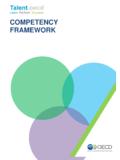Transcription of 25 Training Activities for Creating and Managing Change
1 COMPLIMENTARY RESOURCES from HRD Press 25 Training Activities for Creating and Managing Change Mike Woodcock and Dave Francis HRD Press, Inc. Amherst Massachusetts The 2 Activities in this download are free to use in Training at a single corporate site. COMPLIMENTARY RESOURCES from HRD Press Copyright 1992, 2008, Mike Woodcock and Dave Francis The materials that appear in this book, other than those quoted from prior sources, may be reproduced for educational/ Training Activities . There is no requirement to obtain special permission for such uses. We do, however, ask that the following statement appear on all reproductions: Reproduced from 25 Training Activities for Creating and Managing Change , by Mike Woodcock and Dave Francis.
2 Amherst, MA: HRD Press, 2008. This permission statement is limited to reproduction of materials for educational or Training events. Systematic or large-scale reproduction or distribution or inclusion of items in publications for sale may be carried out only with prior written permission from the publisher. Published in North America by: HRD Press, Inc. 22 Amherst Road Amherst, MA 01002. 1-800-822-2801. 1-413-253-3488. 1-413-253-3490 (fax). In association with Gower Publishing, Ltd. ISBN 0-87425-198-2. Production services by Jean Miller Editorial services by Sally Farnham Cover design by Eileen Klockars The 2 Activities in this download are free to use in Training at a single corporate site.
3 COMPLIMENTARY RESOURCES from HRD Press Contents Introduction .. v Index to Activities .. ix Activities Symbols .. xi The Activities 1. Acquisitions 1. 2. Change Management 7. 3. Charting Company History .. 15. 4. Club Fun: An Introductory Case Study in Managerial Economics .. 29. 5. Decision-Making Styles Review .. 33. 6. The Big-Box Home Improvement Centers Problem .. 45. 7. Dynamic Firepower Corporation: A Case Study .. 53. 8. Generating Strategic Options 63. 9. How to 71. 10. The IT Edge: A Case Study in Managing 87. 11. IT Strategy Checklist .. 93.
4 12. Management Paradigms Questionnaire .. 101. 13. Managing Change .. 107. 14. The Mighty Mouse Organizer Company: A Case Study in Decision Making .. 121. 15. Motivators at Work .. 131. 16. Motorway Garden Diners: A Manager's Dilemma .. 147. 17. Objective-Setting Review .. 159. 18. Obstacles to Planning .. 179. 19. Organizational Options .. 187. 20. Organizational 195. 21. Practical Visioning .. 209. 22. Quality First Audit .. 213. 23. The Sailing Dilemma: A Decision-Making 223. 24. The Sheriff of Nottingham and Robin Hood: A PR Case Study .. 229. 25.
5 Strategic Failure: A Mini-Workshop .. 235. The 2 Activities in this download are free to use in Training at a single corporate site. COMPLIMENTARY RESOURCES from HRD Press The 2 Activities in this download are free to use in Training at a single corporate site. COMPLIMENTARY RESOURCES from HRD Press v Introduction W hen the authors were children, the patterns of life were more predictable. For example, Dave was brought up in a seaside town 50 miles from London, but few people ventured to the big city. Life was conducted within a bicycle ride of home.
6 Almost no one took overseas vacations. Rural life continued almost untouched by factory- farming methods. Regional accents flourished. Organizations endured, year after year, with little apparent Change . People looked for careers that gave them security for life. Attitudes were inculcated by local worthies. The world felt stable and small. Now almost everything is different. Increasingly, the world is a global village. The Internet and e-mail have connected people across continents. Culture is multinational and heroes are global. Organizations Change their structure and scope of operations with increasing frequency.
7 An ever-increasing array of brilliantly innovative new prod- ucts simultaneously captures the imagination of consumers in Hong Kong, Los Angeles, and London. People reshape their lives in continuous adaptation to changing circum- stances. The world is indeed a different place. The scale and scope of social, political, and economic Change means that individu- als can no longer rely on their lives following a predictable pattern. We need the skills to conceptualize what is happening, predict future changes, develop personal strategies, and adapt to new technologies, pressures, and opportunities.
8 Managers, especially, need the skills to manage Change . These can be categorized under four headings: 1. Preparing to manage Change The skills of tracking environmental, social, political, economic, technologi- cal, and industrial forces for Change The skills of conceptualizing external changes and detecting meaningful patterns 2. Articulating choices The skills of predicting the likely flow of changes and detecting both opportunities and threats scenarios of what might happen The skills of exploring possible future strategies 3. Visioning the future The skills of auditing one's own organization in order to determine current strengths and weaknesses The skills of developing a vision of the future that provides a template to effect the transformation of the organization 4.
9 Implementing Change programs The skills of planning effective Change programs The skills of leading and implementing Change programs The 2 Activities in this download are free to use in Training at a single corporate site. COMPLIMENTARY RESOURCES from HRD Press vi Today's ways of thinking about organizational Change are radically different from those of even ten years ago. The Change models we use today are holistic and multi- dimensional. No longer do we use the metaphor of the organization as a puppet theater with the master puppeteer (top management) pulling the strings and the puppets (everyone else in the organization) behaving as commanded.
10 Today we use the meta- phor of the organization as a brain with intelligence distributed widely: Change being ini- tiated and implemented from many sources. Change is indivisible from the process of formulating and implementing corporate strategy. In fact, the strategic process is the way organizations manage Change on the grand scale, just as a campaign plan is the military template for orchestrating Change on the battlefield. For this reason, many of the exercises in this book explore aspects of corporate strategy, which is the primary device for aligning organizations behind a coherent vision of what purposes are served and how those purposes will be achieved.





